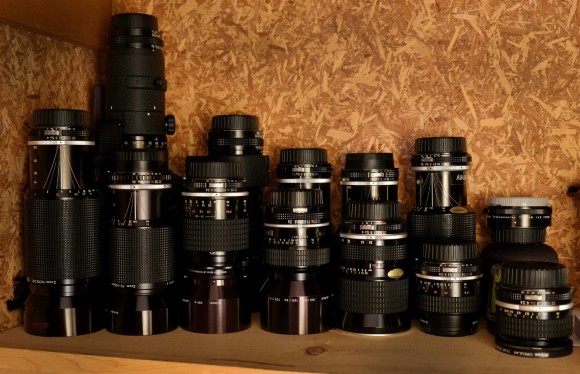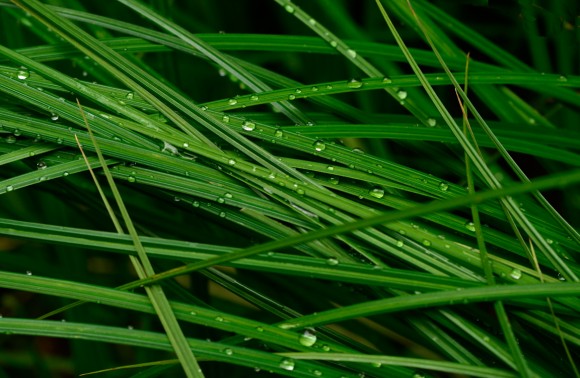Let’s talk lenses…..
John Shaw said, “I never met a lens I didn’t like!” And I said, “Ditto, and I’ve bought most of them!” Above is my collection of Nikon Legacy glass, manual focus lenses from the 70’s and 80’s. I admit it, I love lenses!!! They are the critical part of the photographic system, image sharpness depends on a lot of factors, but without tack sharp lenses, we won’t get tack sharp images!
Let’s get one thing out of the way first, most all lenses today are sharp, some sharper than others, but very few lenses I’ve ever used have not been capable of delivering great detail. So why pick one lens over another? I’ll address that, but first let’s talk some about buying lenses. Forget what you see above, for just a moment, Point (1) Only buy the lenses you need and will use! Point (2) How many lenses can you carry? Point (3) What is the value of lens you own that is at home in the photo closet while you are in Acadia National Park shooting? Zero!!!
But what about your lenses above? O.K. I’m and equipment collector, I plead guilty. I do use those lenses above, but rarely, I just like to have some things that tell the story of my career. The manual focus lenses above are very different from much of what is produced today. They are built like a rock, solid, heavy for their size, and fully mechanical in their operation. They are still capable of making extraordinary images, but they don’t autofocus, they don’t send EXIF data info to the camera, they are “Old School”! They definitely require a lot more attention in their use. I keep a D700 as my manual system digital body and these lenses perform spectacular on that body. I have also used them with the D800 and they are still spectacular (see below)!!
So you ask; “How should I go about purchasing lenses?”
Here are some suggestions;
First think in terms of a system. Once you’ve determined the kind of images you will be making it’s a lot easier to sort out what lenses you will need. Let’s take some examples:
The Sports Photographer’s bag: If you are going to try and capture action in low light you’re going to need: Fast lenses (big apertures in the f 2.8 range), fast auto focus. Since I’m most familiar with Nikon let me suggest a good kit for the Sports shooter:
Fast bodies; D3s or D4 cameras
14-24 f 2.8
24-70 f 2.8
70-200 f2.8 VR II
200-400 f 4 VR II
400mm f 2.8 VR (the focal lengths will depend on the sport but 300mm to 800mm could be found in a top pro’s equipment cases.)
TC-14E teleconverter
The Wildlife Photographer’s Bag:
Much the same as the sports photographer with a special emphasis on long, fast glas
A DX body like the D7000 or D7100 is also a great addition as it will stretch your long glass by a factor of 1.5.
The Nature Photographer’s Bag:
The nature photographer will have some of the same needs in terms of focal lengths, but with today’s camera’s spectacular high ISO/low noise performance, they can save weight with slightly less fast glass!
D600 or D800 camera bodies
16-35 f4 AF-S VR
24-120 f4 AF-S VR
70-200 f4 AF-S VR
80-400 f4.5-5.6 AF-S VR
105 Micro Nikkor f 2.8
The Travel Photographer:
For the travel photographer, weight is the key factor and this can be attacked two ways: either choose the lightest DSLR in Nikon’s case that would be the D7100. or go with a mirror-less system.
Nikon D7100
10-24 AF-S f 3.5 – 4.5
16-85 AF-S VR f 3.5-4.5
70-300 AF-S VR f 4.5-5.6
85mm Micro Nikkor f 3.5
or
A Mirror-less Body
28mm lens
50mm f 1.4 lens
70-200 equivalent lens
60mm micro lens or close-up devices
*Actual focal length and speeds would depend on which of many systems available. Mirror-less is really coming of age and there is now a wide variety of surprisingly fast high quality glass for the various brands available.
The system building goes on as we mention other kinds of photographers. The key is to cover from wide to long in three lenses, (if possible), and be sure to have a way to shoot close-ups.
But how to get the best lenses in each category. fortunately there are plenty of websites dedicated to testing lenses. Read at least four or five reviews to see how much they vary! Photozone, DP Review, The Luminous Landscape, and Ken Rockwell all are good resources. You could also ask a knowledgable friend if you are pulled between several different lenses. You probably know someone, you trust, that has owned the lens you are considering.
What about third party lenses like; Sigma, Tamron, Tokina, etc.? I’ve always made it a personal policy to only buy the lenses made by my manufacturer, I feel knows better what matches their body. Sometimes you simply can’t get what you need from your brand and then you might consider one of the other brands. Just check carefully the mechanical construction, and read the reviews carefully, they will point any function your camera may have, that some these lenses may not support.
Nothing robs your fun as a photographer worse than the fatigue that sets in from carrying a lot of heavy equipment all day! Collect as much as you wish, but don’t try to carry too much and you will enjoy the process a lot more!
Blessings.
the pilgrim
This entry was posted on Monday, April 29th, 2013 at 4:42 pm
You can follow any responses to this entry through the RSS 2.0 feed.





I love old lenses. I have a fully manual 55mm f/1.2 lens from the late 70’s that takes dreamy pictures. I hate to even take it off my camera.
That was, and still is, one spectacular lens, they are still very highly prized!
[…] buying) and what you should consider if some of those lenses are available on the used market. Click here for a great little article on lenses and systems and lightening that bulging camera bag. And click here for advice on buying […]
Hello, this weekend is nice in support of me,
as this time i am reading this great educational piece of writing here
at my house.